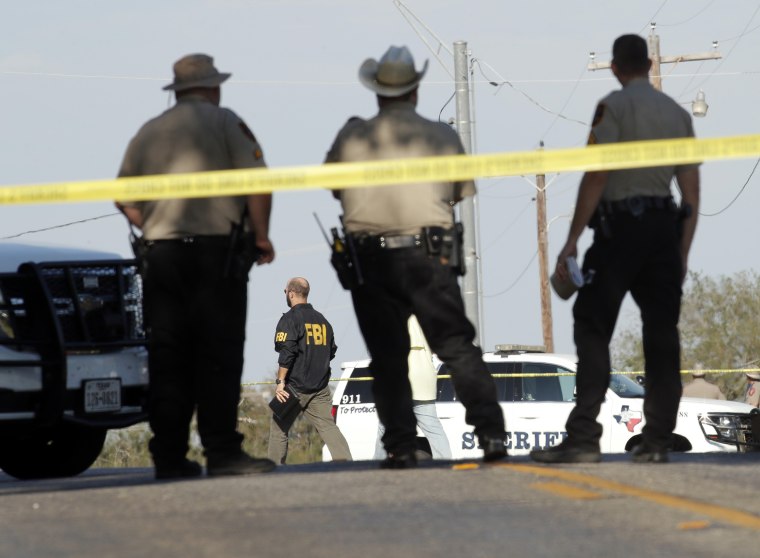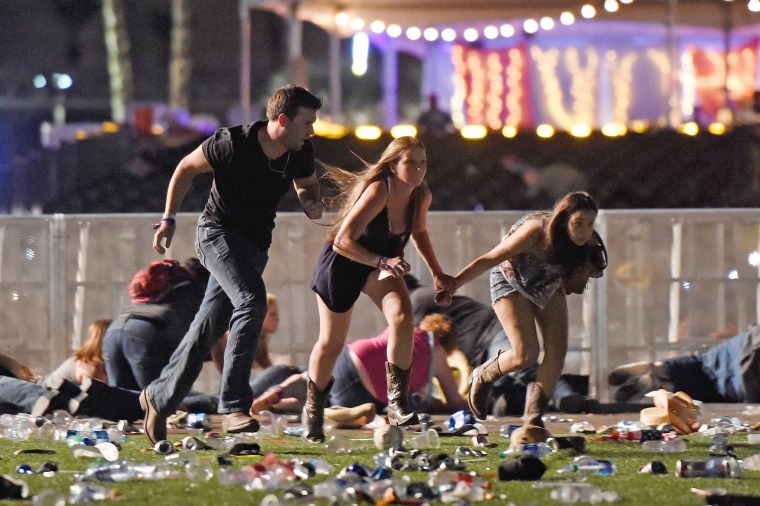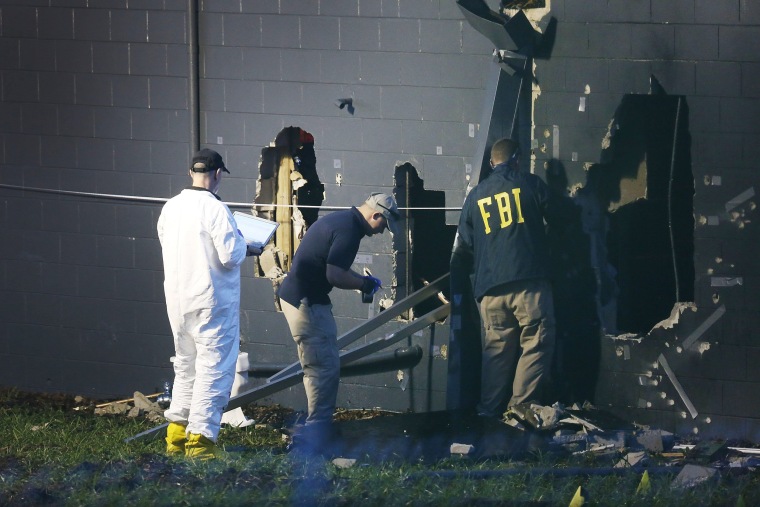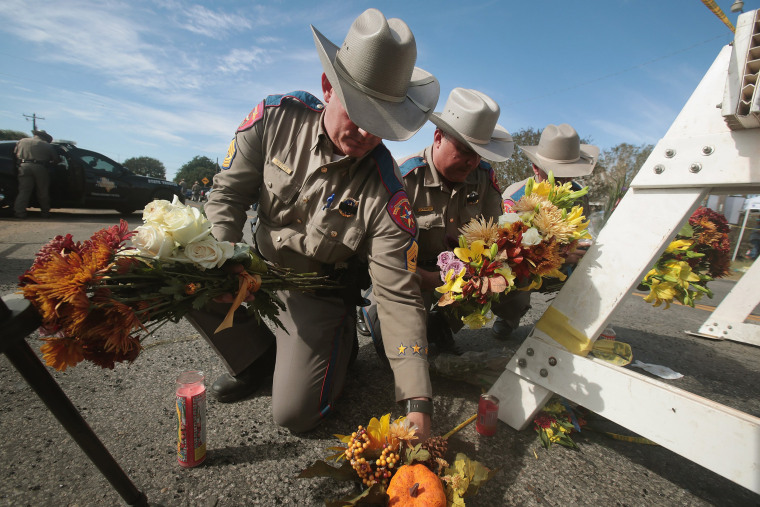With the slaughter of 26 people at a Texas church on Sunday, two of the deadliest mass shootings in American history have taken place in the span of just over a month — and experts said these types of cases have gotten deadlier in recent years.
“If we look at say the top seven in terms of how deadly they’ve been, five of the seven deadliest have been in the last 10 years,” said Grant Duwe, a criminologist and author of "Mass Murder in the United States: A History."
Duwe, who is the research director for the Minnesota Department of Corrections, said that while the rate of mass public shootings has not really increased in the past few decades, these cases have recently gotten more severe — both in the number of victims killed and the number of victims wounded.
Four of the five deadliest mass public shootings in U.S. history have occurred in the last five years: the attack at a music festival last month in Las Vegas (58); at a nightclub in Orlando, Florida, in 2016 (49); at Virginia Tech in 2007 (32); at Sandy Hook Elementary School in Newtown, Connecticut, in 2012 (27); and at the First Baptist Church on Sunday in Sutherland Springs, Texas (26).
Duwe said his research revealed a grim statistic: “With 94 victims killed so far this year, 2017 has been the deadliest year for mass public shootings in American history,” he said.

That research defines “mass public shooting” as four or more victims killed with a firearm in a 24-hour period in a public location that is absent of other criminal activity, such as gang violence or a robbery. Duwe said his research goes back to the year 1900.
Related: Air Force Failed to Report Church Gunman's Convictions
The FBI has defined “mass murder” as the killing of four or more people within one event, according to a Congressional Research Service report.
With the attack in Texas on Sunday, where authorities say 26 people were killed, Duwe said, “it’s difficult to deny the fact that there has been an increase in the severity of mass public shootings."

What statistics show, according to experts
The United States also has more mass public shootings than any other country in the world, according to Adam Lankford, a criminology professor at the University of Alabama who wrote a recent study on mass shooters and firearms spanning 171 countries.
Lankford said his statistical analysis looked at a variety of factors, including mental health, firearm ownership rates, and homicide and suicide rates.
“It’s a mathematical model that decides what’s important, and in this case it was far and away the firearm ownership rate which explained why some countries had more mass shooters than others,” he said.
Related:Texas Church Shooter May Have Been Targeting His Mother-in-Law
The study concluded that the “United States and other nations with high firearm ownership rates may be particularly susceptible to future public mass shootings, even if they are relatively peaceful or mentally healthy according to other national indicators.”
Lankford said it was “pretty disturbing” that two of the nation’s deadliest shootings had happened within the last 35 days, and while motivations varied in such attacks, research and evidence left behind by gunmen in previous cases have shown that "these shooters do influence each other."
“I guess what a lot of average citizens would wonder is, are they connected? Is this an aberration that we’ve had these two shootings in such short proximity of each other or not?” he said.
Lankford noted examples where gunmen had left manifestos writing that they had been influenced by previous mass shooters. For example, more than 30 subsequent shooters cited the 1999 Columbine high school gunmen as a source of inspiration, he said.
"So the concern is, each one of these individuals who commit such a deadly attack could be a role model for future attackers, and of course that can explain why things could get worse in terms of America," he said. "America has more potentially deadly role models than it did two days ago."

Sherry Towers, a research professor at Arizona State University who has studied the spread of contagious disease in populations, published a study on “contagion in mass killings and school killings” after she noticed reports of three school shootings in a 10-day period in 2014.
Using a statistical model, the study found "significant evidence that mass killings involving firearms are incented by similar events in the immediate past."
"The way it manifests itself is usually a clustering together in time more than you’d expect by mere random chance," Towers said.
Towers' study also found that higher gun ownership and availability of firearms in a state were also factors.
Related: If Trump’s Blaming Mental Health, Why Did He Gut This Obama Gun-Check Rule?
She agreed with Duwe that, while data did not show a significant upward trend in the frequency of mass public shootings from year to year, "there is a significant trend upward in casualty count."
In Washington, Democratic lawmakers have once again renewed their call for gun control measures following the church shooting, which was the largest mass shooting in Texas history.
President Donald Trump said the attack Sunday was not “a guns situation” but instead "a mental health problem." But both Lankford and Towers said their work did not show mental health to be a significant factor in their studies, while gun ownership was.
The National Rifle Association did not immediately respond to a request for comment on the Texas church shooting and the increase in the severity of deadly mass public shootings.
Lack of research
Duwe cautioned that “the evidence currently is not there” on whether certain gun control measures would significantly reduce the risk of such violence.
Part of the problem, he noted, is “there’s been so little rigorous research that’s been done on the topic that you could look at it from a number of different angles."
Duwe said research was needed on a variety of subjects related to gun violence and policy for it to “potentially be possible at some point to develop some kind of strategies that might reduce this type of violence.”
Towers said there was a lack research on the issue from the Centers for Disease Control and Prevention because of an amendment Congress added to a spending bill in 1996, which was strongly supported by the NRA, that said no funds made available to the CDC "may be used to advocate or promote gun control."
Related: More Than Two Dozen Killed in Rural Texas Church Shooting
While the language did not specifically prohibit research on gun violence, Congress also redistributed $2.6 million of the CDC's budget — the exact amount that had been invested in previous firearm research — to focus on prevention of traumatic brain injury.
Towers said the move has had a chilling effect on CDC research on the subject.
Gun violence is the least-researched cause of death, according to a study published this year.
CDC spokeswoman Courtney Lenard said in a statement that the language on the gun-control appropriations ban, which took effect at the CDC in fiscal year 1997, was extended to all Department of Health and Human Services agencies in fiscal year 2012.
But that language "does not prohibit CDC from conducting research or collecting public health data on firearm violence," she said.
"Firearm-related injuries are among the five leading causes of death for people ages 1-64 in the United States," she added. "CDC has and continues to support data collection activities and analyses to document the public health burden of firearm injuries in the U.S."
Photos: Two Dozen Parishioners Killed in Texas Church Shooting
After the 2016 mass shooting in Orlando, the American Medical Association (AMA) adopted a policy calling gun violence in the U.S. a "public health crisis." The AMA also said it resolved to actively lobby Congress "to overturn legislation that for 20 years has prohibited the Centers for Disease Control and Prevention (CDC) from researching gun violence."
"Even as America faces a crisis unrivaled in any other developed country, the Congress prohibits the CDC from conducting the very research that would help us understand the problems associated with gun violence and determine how to reduce the high rate of firearm-related deaths and injuries," AMA President David O. Barbe said in a statement to NBC News on Tuesday.
Towers, of Arizona State, said that the result of the provision was that "the studies that are coming out are relying on private sector funding or scientists putting in the time by themselves."
This means, she added, that while the U.S. had the highest prevalence of mass shootings and other gun violence compared to other developed countries, "basically we are not publicly funding any kind of research that goes into that."

